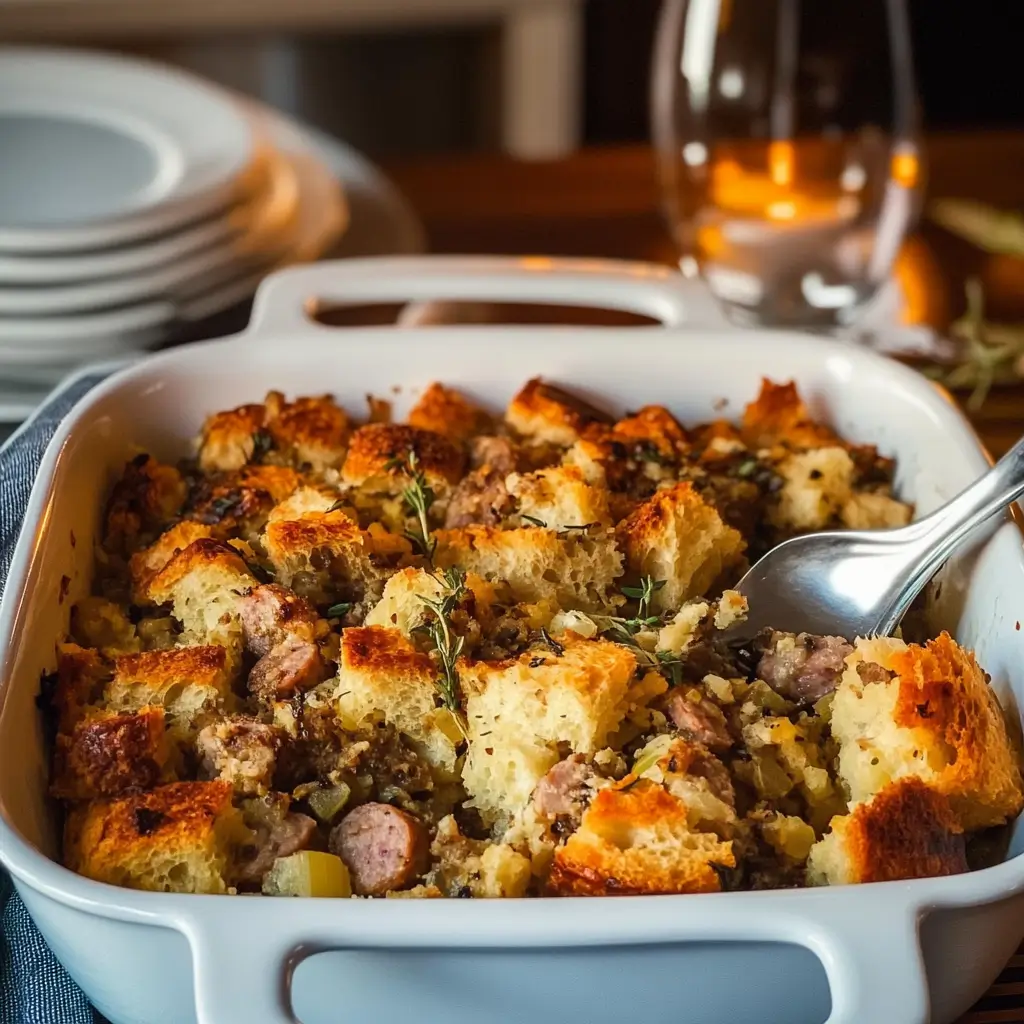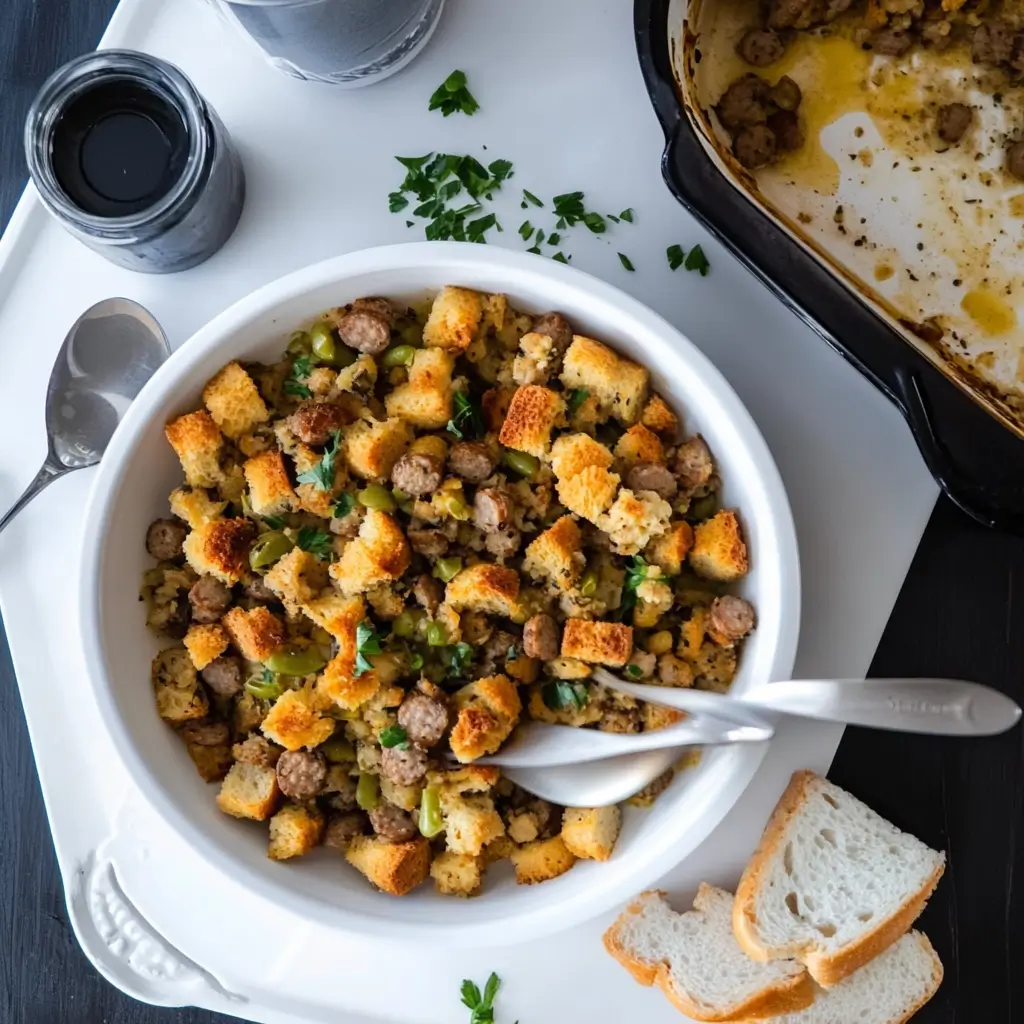The holidays are the time when many of us revisit old family recipes, some passed down through generations. Among these, old-fashioned bread and sausage stuffing holds a special place on the holiday table. Its rich flavors, combining hearty bread and savory sausage, make it a perfect side dish for any feast. Whether you’re preparing it for Thanksgiving, Christmas, or just a cozy family meal, this stuffing recipe promises to deliver comfort and tradition.
This version draws inspiration from classic bread stuffing but includes a few tweaks to make it even better. It blends the best elements of the old-fashioned recipe with modern additions, like sausage, which adds a delightful depth of flavor.
In this article, we’ll take a closer look at how to make this stuffing, explore tips and tricks to perfect it, and uncover some potential variations you can try. Let’s dive in!

Ingredients
To create a stuffing that’s both flavorful and satisfying, you need a mix of classic ingredients, along with some quality additions. Here’s what you’ll need:
-
Bread: The foundation of any great stuffing. We recommend using a hearty white bread, sliced and cubed.
-
Sausage: Adds a savory punch to the stuffing. We’ll use bulk pork sausage, but feel free to switch things up with your preferred sausage.
-
Herbs: Sage and thyme are staples for an aromatic stuffing, providing the earthy, savory notes that make this dish unforgettable.
-
Vegetables: Celery, carrots, and onion are essential for providing texture and natural sweetness.
-
Stock: Homemade turkey stock or chicken broth is ideal for soaking the bread and tying all the ingredients together.
Helpful Tips for Perfect Stuffing
-
Use Day-Old Bread: Fresh bread can make your stuffing soggy. Day-old bread works best because it’s drier and absorbs the liquids better.
-
Add More Sausage: If you love sausage, feel free to use 1½ pounds instead of 1 pound. It will enhance the sausage flavor throughout the stuffing.
-
Make Ahead: You can prepare the stuffing the day before and refrigerate it overnight. Just cover the casserole with foil and bake it the next day. You may need to adjust the baking time slightly if the stuffing is cold from the fridge.
-
Texture Variations: If you like your stuffing on the more moist side, add a bit more stock to your mixture. For a firmer stuffing, reduce the stock slightly.
-
Herb Variations: While sage and thyme are the traditional herbs, you can experiment with rosemary or marjoram for added depth of flavor.

Why This Stuffing Recipe Stands Out
This Old Fashioned Bread and Sausage Stuffing recipe takes traditional flavors and elevates them with small but impactful changes. Here’s why it stands out compared to other stuffing recipes you might find:
-
The Sausage Addition: Traditional bread stuffing often lacks the depth and heartiness that sausage brings. Sausage adds a savory richness that is not only comforting but also enhances the overall flavor profile. Whether you opt for mild or spicy sausage, the key is using high-quality pork sausage for the best result. This addition makes the stuffing perfect for those who want something beyond the standard bread-based side dish.
-
Homemade Stock: While many recipes call for store-bought broth, homemade turkey stock is what truly elevates this stuffing. The rich flavor of turkey stock brings a layer of depth that can’t be matched by store-bought versions. If you’re short on time, chicken broth is an acceptable substitute, but for the ultimate stuffing experience, turkey stock is a must.
-
Herb-Infused Flavor: The combination of fresh sage and thyme is quintessential to the flavor of this dish. Fresh herbs provide a fragrant, earthy aroma that perfectly complements the savory sausage and the natural sweetness of the vegetables. The herbs in the stuffing are subtle yet essential, and they help balance the dish’s richness.
-
Perfect Texture: The key to great stuffing is balancing moisture and crispiness. By toasting the bread cubes before adding them to the mixture, you ensure they won’t turn soggy but instead will soak up the stock while retaining their texture. The result is a stuffing that’s crispy on top and moist inside — just the way stuffing should be.
-
Adaptable to Dietary Preferences: While this recipe uses pork sausage, you can easily swap it out for turkey sausage, chicken sausage, or even a vegetarian sausage alternative. Additionally, for those who prefer a gluten-free option, you can substitute the bread with gluten-free bread. The recipe is versatile enough to accommodate various dietary needs without compromising on flavor.

Common Mistakes to Avoid
To ensure your Old Fashioned Bread and Sausage Stuffing turns out perfect, here are a few common mistakes to avoid:
-
Using Fresh Bread: Fresh bread might seem like a good idea, but it will turn soggy when soaked in liquid. Use slightly stale or day-old bread for a better texture.
-
Not Toasting the Bread: Skipping the bread toasting step is a mistake. Toasting the bread cubes ensures they maintain their structure and don’t get mushy during baking.
-
Not Adjusting Seasoning: Bread absorbs a lot of the flavors, so it’s crucial to taste and adjust seasoning. Don’t be afraid to add extra salt or pepper as needed.
-
Over-Baking: If you bake the stuffing for too long, it could become overly dry. Aim for a golden brown, crisp top while keeping the center moist. The resting time after baking allows the flavors to meld together and prevents it from drying out.
Variations to Try
If you want to give your stuffing a unique twist, here are some creative variations you can try:
-
Apple and Sausage: Add diced apples to the stuffing for a sweet contrast to the savory sausage. The sweetness of apples pairs beautifully with the richness of the sausage and herbs.
-
Mushrooms: For an earthy flavor, add sautéed mushrooms to the mix. They’ll enhance the depth of the stuffing and add a satisfying texture.
-
Dried Fruits and Nuts: For a festive flair, you can add dried cranberries or raisins, along with some chopped pecans or walnuts. This combination adds sweetness, crunch, and a holiday vibe.
-
Spicy Kick: If you enjoy a bit of heat, add some red pepper flakes or spicy sausage to the recipe. The kick will complement the rich flavors without overwhelming the dish.

The Importance of Stock in Stuffing
One of the key elements in making stuffing is the stock. Whether you use turkey stock, chicken broth, or a vegetable stock, it’s important to use a rich, flavorful liquid to moisten the bread cubes. Here’s a quick rundown of how stock can affect the outcome:
-
Turkey Stock: This is the ultimate stock for stuffing, especially during Thanksgiving when you have turkey leftovers. It adds a deep, savory flavor to the stuffing, and the richness of turkey stock complements the sausage beautifully.
-
Chicken Broth: A more common and accessible option, chicken broth will provide a lighter flavor but still deliver the moisture the bread needs.
-
Vegetable Broth: For a lighter, vegetarian-friendly version, vegetable broth is a great option. It’s flavorful and provides a good base without overpowering the stuffing’s other ingredients.
-
Homemade Stock: If you have the time, homemade stock is always the best choice. It’s richer, more flavorful, and free from the preservatives often found in store-bought versions. Plus, it’s an excellent way to use up leftover turkey or chicken bones.
If you don’t have homemade stock available, opt for high-quality store-bought stock to ensure your stuffing has the flavor it needs.

Making Stuffing Ahead of Time
One of the most attractive features of this Old Fashioned Bread and Sausage Stuffing is how well it holds up when made in advance. You can easily prepare this dish the day before your holiday meal, allowing the flavors to meld overnight, which often improves the taste. Here’s how to do it:
-
Assemble the Stuffing: Follow the recipe as instructed, but instead of baking it right away, transfer the stuffing to a buttered baking dish. Cover it tightly with plastic wrap or aluminum foil.
-
Refrigerate Overnight: Place the stuffing in the fridge and allow it to sit overnight. The bread will soak up the stock and flavors, making it even more flavorful when it’s baked.
-
Bake on the Day: The next day, take the stuffing out of the fridge and let it sit at room temperature for about 30 minutes before baking. Bake as directed, but you may need to add an additional 15-20 minutes to the baking time since the stuffing is cold from the fridge.
Making stuffing ahead of time can save you valuable preparation time on the day of your meal, leaving you more time to focus on the main course and other side dishes.

FAQs On Old Fashioned Bread and Sausage Stuffing
How to make sausage and bread stuffing?
To make sausage and bread stuffing, start by toasting cubes of bread until they are golden and crispy. In a skillet, cook diced vegetables such as celery, onions, and carrots in melted butter until softened. Brown sausage in the same skillet, then combine the sausage and vegetables with the toasted bread. Add fresh herbs like sage and thyme, then moisten the mixture with turkey or chicken stock. Bake the stuffing until the top is crispy and golden. For detailed instructions, follow our step-by-step recipe.
What is traditional stuffing made of?
Traditional stuffing is typically made from cubed bread, onions, celery, butter, herbs like sage and thyme, and stock or broth. Some variations also include sausage, dried fruits, or nuts. It’s often cooked inside the turkey (making it “stuffing”) or outside in a casserole dish (making it “dressing”). The base of bread, vegetables, and herbs remains constant, providing a flavorful, savory side dish.
Do you put egg in sausage stuffing?
Eggs are not typically included in the Old Fashioned Bread and Sausage Stuffing recipe. The bread cubes absorb the stock and moisture from the sausage and vegetables, making eggs unnecessary. However, some stuffing recipes do include eggs to help bind the ingredients, especially if you’re making a very firm stuffing.
Do you put carrots in stuffing with sausage?
Yes, carrots are a common addition in many sausage stuffing recipes. They provide natural sweetness and add texture to the stuffing. In this recipe, finely diced carrots are sautéed with celery and onions to create a flavorful vegetable base that pairs perfectly with the sausage and herbs.
What kind of sausage to put in stuffing?
For sausage stuffing, it’s best to use bulk pork sausage (the kind that comes in a casing and can be removed). The pork sausage is flavorful and adds a rich, savory taste to the stuffing. You can choose between mild or spicy sausage depending on your preference. For a lighter option, you could use turkey sausage, or for a more adventurous flavor, try using sage sausage or Italian sausage for a slightly different twist.

Recipe Card: Old Fashioned Bread and Sausage Stuffing
Ingredients
-
½ cup unsalted butter (1 stick), more for greasing the baking dish
-
2 lbs good quality white bread, cut into 1-inch cubes (about 20 cups)
-
4 ribs celery (including leafy tops), finely diced (1½ cups)
-
2 carrots, finely diced (1 cup)
-
1 sweet onion, finely diced (2½ cups)
-
1 lb bulk pork breakfast sausage
-
2 tbsp finely chopped fresh sage
-
2 tbsp finely chopped fresh thyme
-
3 cups homemade turkey stock (or chicken broth)
-
Kosher salt and freshly cracked black pepper to taste
Instructions
-
Preheat oven to 350°F (175°C). Spread bread cubes on two large baking sheets and toast for 30 minutes, stirring halfway through, until lightly browned and crisp. Transfer bread cubes to a large mixing bowl.
-
In a large skillet, melt 1 stick of butter. Add diced celery, carrots, and onion, along with a pinch of salt. Cook over medium-high heat for 8 to 10 minutes until vegetables are softened and beginning to brown. Transfer vegetables to the bowl with the bread cubes.
-
Add sausage to the same skillet and break it up into chunks. Cook until browned and crumbled, about 6 minutes.
-
Return vegetables to the skillet with sausage. Add sage, thyme, salt, and pepper. Stir and cook for 1 minute, then add 1 cup of turkey stock. Stir to loosen any browned bits, and cook until the stock has reduced by half, about 5 minutes.
-
Transfer the sausage mixture into the bowl with the bread cubes. Add the remaining 2 to 2½ cups of stock and toss everything to combine. Adjust seasoning with salt and pepper.
-
Lightly butter a 3½-quart baking dish. Spread the stuffing into the dish and brush the top with the reserved melted butter.
-
Bake in the center of the oven for about 1 hour, or until the top is golden and crisp. Rotate halfway through for even browning. Let the stuffing rest for 10 minutes before serving.
Notes
-
Make Ahead: You can prepare the stuffing the day before and store it in the refrigerator overnight. Just bake it the following day.
-
Sausage Options: For a different flavor, try using turkey sausage, chicken sausage, or a vegetarian sausage alternative.
-
Gluten-Free Version: Substitute the bread with gluten-free bread for a gluten-free stuffing option.
-
Apple Variation: Add diced apples for a sweet contrast to the savory sausage.
Nutritional Facts (Per Serving)
| Nutrient | Amount |
|---|---|
| Calories | 420 kcal |
| Carbohydrates | 42g |
| Protein | 15g |
| Fat | 21g |
| Saturated Fat | 9g |
| Polyunsaturated Fat | 3g |
| Monounsaturated Fat | 7g |
| Trans Fat | 1g |
| Cholesterol | 49mg |
| Sodium | 705mg |
| Potassium | 339mg |
| Fiber | 3g |
| Sugar | 6g |
| Vitamin A | 2081 IU |
| Vitamin C | 4mg |
| Calcium | 189mg |
| Iron | 3mg |
Recipe Details
-
Prep Time: 1 hour
-
Cook Time: 1 hour
-
Total Time: 2 hours
-
Method: Baking, Stovetop
-
Cuisine: American
